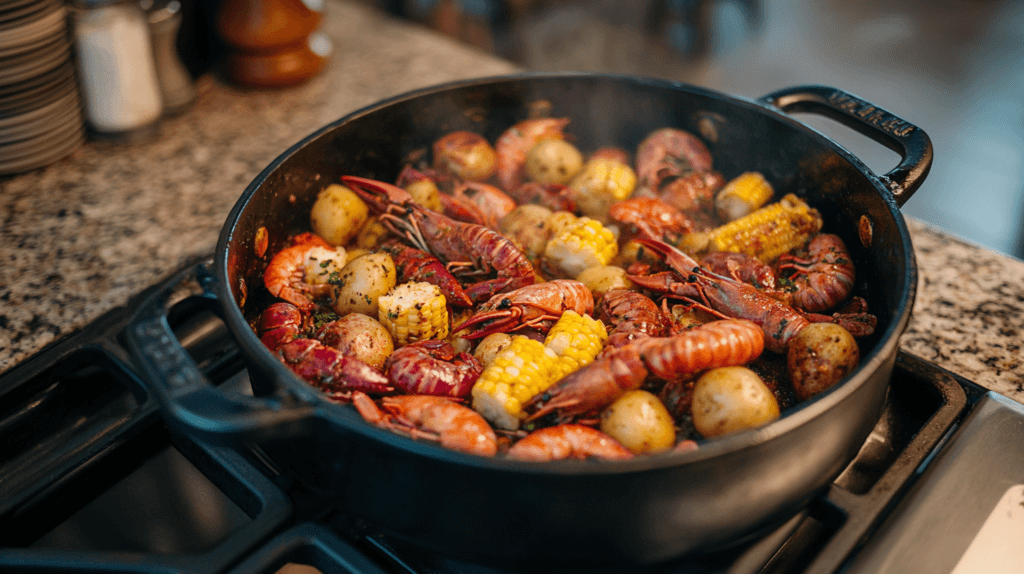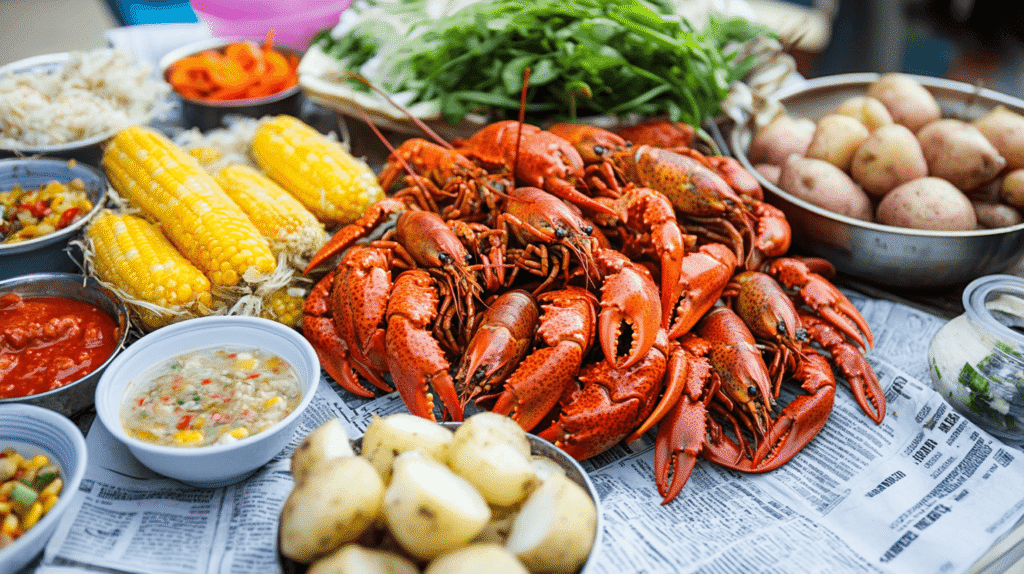Seafood boils are a beloved culinary tradition, celebrated for their vibrant flavors and communal style of eating. If you’ve ever attended one, you might have wondered about its origins: Is seafood boil Cajun or Creole?
The answer lies in the rich culinary history of Louisiana and the Gulf Coast, where both Cajun and Creole cultures have left their mark. While both have influenced the seafood boil tradition, their styles differ in ingredients, techniques, and cultural significance.
In this article, we’ll dive into the fascinating origins of seafood boils, explore the defining characteristics of Cajun and Creole cuisines, and help you tell the difference between the two styles. Whether you’re a seasoned food enthusiast or a curious newcomer, this journey will leave you with a deeper appreciation for this flavorful feast.
Table of Contents
Understanding Cajun and Creole Cuisines
Before we explore seafood boils, it’s important to understand the differences between Cajun and Creole cuisines two distinct but often intertwined traditions.
What Is Cajun Cuisine?
Cajun cuisine originates from the Acadians, French settlers exiled from Canada who resettled in Louisiana in the 18th century. Rooted in rural traditions, Cajun cooking emphasizes resourcefulness, bold flavors, and local ingredients.
Key characteristics of Cajun cuisine:
- Focus on simplicity: One-pot meals like gumbo and jambalaya.
- Bold use of spices: Cayenne, paprika, garlic powder, thyme.
- Local staples: Crawfish, shrimp, andouille sausage, and seasonal vegetables.
- Minimal tomato use: Tomatoes are rare in Cajun cooking.
What Is Creole Cuisine?
Creole cuisine reflects a multicultural mix of French, Spanish, African, Caribbean, and Native American influences, emerging from New Orleans’ vibrant culture. It’s often viewed as more “city-style” and sophisticated compared to rustic Cajun fare.
Key characteristics of Creole cuisine:
- Complex flavors: Layered with a broad range of spices and ingredients.
- Tomato-based dishes: Such as shrimp Creole and red jambalaya.
- Seafood focus: Shrimp, crab, oysters are frequent stars.
- Rich sauces: Roux- or cream-based sauces are common.
Quick Comparison: Cajun vs. Creole
| Aspect | Cajun | Creole |
|---|---|---|
| Ingredients | Local, rustic | Diverse, global |
| Spices | Bold, smoky, spicy | Balanced, aromatic |
| Tomatoes | Rarely used | Commonly used |
| Cultural Influence | French-Acadian, rural | Multicultural, urban |
Understanding these distinctions sets the stage for exploring how both cultures influence seafood boils.
The Origins: Is Seafood Boil Cajun or Creole?
Seafood boils are rooted in the food traditions of the Gulf Coast, especially Louisiana. They represent a fusion of Native American, European, African, and Caribbean culinary practices, tied closely to geography, history, and community celebration.
How Did Seafood Boils Begin?
The earliest seafood boils were inspired by Native American practices, using local seafood like crawfish and shrimp cooked over open fires with herbs. European settlers later introduced spices and boiling techniques, while African and Caribbean influences added rich, bold seasoning.
Seafood boils became not only a practical cooking method but also a festive, communal gathering a tradition that continues today.
Geography’s Role
Louisiana’s bayous, rivers, and proximity to the Gulf of Mexico provided an abundance of crawfish, shrimp, crab, and oysters. The use of imported spices (like cayenne and paprika) further shaped the bold flavors we associate with today’s seafood boils.
Both Cajun and Creole communities relied on these natural resources but adapted them through their distinct cooking styles.
Cajun Influence on Seafood Boils

Cajun-style seafood boils showcase the bold, rustic spirit of rural Louisiana.
Ingredients Commonly Found in Cajun Seafood Boils:
- Crawfish (mudbugs)
- Shrimp and crab
- Corn on the cob and red potatoes
- Andouille sausage
- Bold Cajun seasoning (heavy in cayenne and paprika)
Cooking Techniques and Flavor Profiles
- Everything in one pot: Seafood and vegetables are boiled together.
- Spice-forward: Hearty, unapologetically spicy flavors dominate.
- Layered flavor: Ingredients are added at different times for perfect doneness.
- Casual serving: Typically dumped onto newspaper-covered tables for communal eating.
Creole Influence on Seafood Boils

Creole-style boils reflect a more refined, aromatic approach, influenced by New Orleans’ multicultural roots.
Ingredients in Creole Seafood Boils:
- A wider variety of seafood (including lobster and mussels)
- Tomatoes or tomato-based broth (sometimes)
- Bell peppers, celery, and onions (“holy trinity”)
- Aromatic seasoning (thyme, bay leaves, cloves)
Cooking Techniques and Flavor Profiles
- Aromatic layering: Herbs like parsley and thyme add complexity.
- Butter-based sauces: Dipping sauces may accompany the seafood.
- Elegant presentation: Often served on platters or in bowls.
How to Tell If Your Seafood Boil Is Cajun or Creole
Here’s how to spot the differences:
| Category | Cajun Boil | Creole Boil |
|---|---|---|
| Spice Profile | Spicy, bold, smoky | Aromatic, balanced, layered |
| Ingredients | Crawfish, shrimp, crab, sausage | Broader seafood variety, vegetables, tomato broth |
| Cooking Style | One-pot, rustic, messy | More steps, elegant presentation |
| Serving Style | Dumped onto newspaper tables | Plated or served with sauces |
Regional Variations in Seafood Boils
As seafood boils spread, they evolved into different regional styles:
Gulf Coast Seafood Boils
- Abundant shrimp and blue crab
- Use of Old Bay seasoning
- Sausage varieties, sometimes specific to Texas or Mississippi
Louisiana Seafood Boils
- Rural areas: More Cajun-style (bold, spicy)
- Urban areas (like New Orleans): More Creole-style (rich, elegant)
Modern Takes
- Asian Fusion Boils: Flavors like lemongrass and ginger.
- Vegetarian Boils: Featuring tofu, artichokes, Brussels sprouts.
- Creative Mashups: Blending Cajun, Creole, and international flavors.
Frequently Asked Questions (FAQs)
What’s the difference between Cajun and Creole seasoning?
Cajun seasoning is spicier and more robust; Creole seasoning is aromatic with herbs like thyme and bay leaves.
Are seafood boils only popular in Louisiana?
No they’re beloved across the Gulf Coast and now popular nationwide.
Can you combine Cajun and Creole styles?
Absolutely! Many chefs create boils blending spicy and aromatic elements for a unique experience.
What drinks pair best with seafood boils?
Light beer, sweet iced tea, lemonade, or a crisp white wine.
Are seafood boils a modern invention?
No they date back centuries, influenced by Native American, French, African, and Caribbean culinary traditions.
What other dishes are closely related?
Gumbo, jambalaya, and étouffée share similar ingredients and spices.
Conclusion
Is seafood boil Cajun or Creole?
The truth is, it can be either or a beautiful combination of both.
Cajun boils are bold, spicy, and rustic. Creole boils are complex, aromatic, and elegant. Together, they reflect the rich cultural tapestry of Louisiana and the Gulf Coast, where food isn’t just about sustenance it’s about bringing people together in celebration.
Whichever style you choose, one thing’s certain: a seafood boil is a vibrant, flavorful feast meant to be shared.

